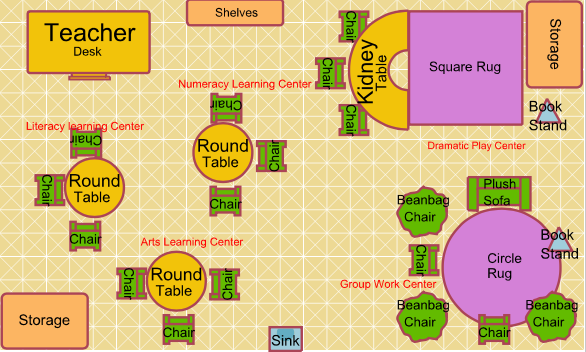The classroom learning environment is crucial to promote effective learning and ensure positive behavior of students. According to Guardino and Antia (2012), “The physical arrangement and features of the classroom environment, such as seating arrangements, lighting, and organization, can influence students’ behavior and attention to academic tasks” (p. 518). For younger students, the classroom environment is of primary importance, as students spend the vast part of their day in one classroom. The two classroom plans produced as part of the assignment fulfill the requirements defined by research studies, thus enabling students to learn more effectively.

The first plan is for a pre-K stage classroom (Figure 1). As seen from the labels, the classroom is separated into various learning and activity centers, such as a dramatic play center, arts center, and more. According to Rohrer and Samson (2014), ensuring that the classroom is separated into several sections used for different purposes enhances the learning environment. Each learning center in the classroom is equipped with the necessary materials to promote learning. For instance, the art learning center is located close to the sink and storage area, which allows students to have access to the necessary supplies, such as paper, paint, and other materials. The literacy learning center is located near the shelves and the teacher’s desk.
According to research ensuring the availability of reading and writing materials, as well as instructional support, is significantly associated with the development of alphabet knowledge and name-writing ability in preschool children (Guo, Justice, Kaderavek, & McGinty, 2012). The group work area, on the other hand, has comfortable seating. Individual chairs can be used by students who are shyer to reduce the anxiety of participating in a shared activity, whereas the sofa and beanbag chairs will be useful for more relaxed students. The group work area can also be used for rest and play; the presence of a comfortable area that is suitable for different activities contributes to a positive learning environment (Bautista & Borges, 2013). Overall, the constructed pre-K classroom enables students to collaborate and learn in a positive and comfortable environment.
The second floorplan was designed for children in the first grade of school (Figure 2) and represents a transition from a highly diverse classroom used mainly for academic play to a more traditional learning setting that is still equipped with all the necessary tools to ensure comfortable and efficient learning. Similarly to the pre-K classroom, it is separated into different activity areas. According to Rohrer and Samson (2014), distinctive classroom areas convey the teacher’s expectations about appropriate behavior to students, thus aiding them in entering the desired mindset for the activity.
The classroom plan contains a general learning area, designed for students to receive instruction and work on individual or paired task. The science learning and group work area use two kidney tables to form a large round learning space, allowing all students to see one another, which is crucial to engage in group work or discussion. Lastly, there is a rest and play area that is separated from the general learning area by a set of shelves. The rest and play area feature all the necessary components to provide students with a comfortable environment in-between activities. According to Bautista and Borges (2013), carpets, pillows, sofas, and other attributes designed to improve comfort promote student well-being.

Finally, maintaining the cleanliness and organization of learning and rest areas can help to ensure that the condition of the classroom is perceived as excellent both by parents and students, as student perception of classroom condition was found to be an important predictor of motivation and learning outcomes (Asiyai, 2014). Overall, both classroom floorplans exhibit features that help to establish a positive learning environment, thus allowing students to achieve their full learning potential.
References
Asiyai, R. (2014). Students’ perception of the condition of their classroom physical learning environment and its impact on their learning and motivation. College Student Journal, 48(4), 714-723.
Bautista, G., & Borges, F. (2013). Smart classrooms: Innovation in formal learning spaces to transform learning experiences. Bulletin of the IEEE Technical Committee on Learning Technology, 15(3), 18-21.
Guardino, C., & Antia, S. D. (2012). Modifying the classroom environment to increase engagement and decrease disruption with students who are deaf or hard of hearing. Journal of Deaf Studies and Deaf Education, 17(4), 518-533.
Guo, Y., Justice, L. M., Kaderavek, J. N., & McGinty, A. (2012). The literacy environment of preschool classrooms: Contributions to children’s emergent literacy growth. Journal of Research in Reading, 35(3), 308-327.
Rohrer, M., & Samson, N. (2014). 10 critical components for success in the special education classroom. Thousand Oaks, CA: Corwin Press.